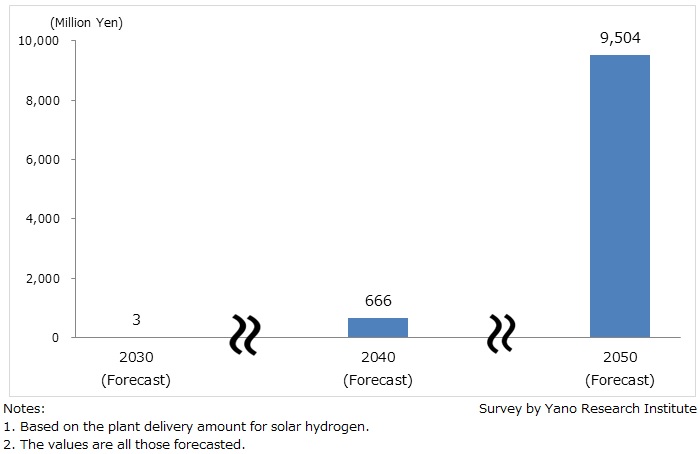No.3113
Global Artificial Photosynthesis Market: Key Research Findings 2022
Global Solar Hydrogen Market Projected to Generate 9,500 Million Yen by 2050
Yano Research Institute (the President, Takashi Mizukoshi) carried out a research on the global market of artificial photosynthesis, and found out the research and development trends, challenges geared to practical application, and future perspectives until 2050. This press release discloses the global market size forecast for solar hydrogen (hydrogen generated by water splitting reactions).

Market Overview
Artificial photosynthesis uses solar energy accumulation reaction (a process to convert light energy to chemical energy) to artificially generate the energy necessary for human activities from water. In recent years, social implementation for artificial photosynthesis which can generate hydrogen and organic compound from water and carbon dioxide by using inexhaustible sunlight energy has become practical. Especially, Japan, with the world’s top class studies on photocatalysts, is proactive in practicability verification, etc.
Artificial Photosynthetic Chemical Process (ARPChem), at its primary period (FY2012 to FY2021), has developed many of visible light responsive photocatalysts that can be the keys for social implementation in the “Artificial Photosynthesis Project” taken initiative by NEDO (New Energy and Industrial Technology Development Organization). NEDO says that the goal of this project is to partially imitate the plant photosynthesis process-which is used to produce key chemicals, including plastic raw materials from CO2 and hydrogen from sunlight and water (solar-hydrogen)—in order to realize the practical application of an innovative chemical manufacturing process that does not rely on fossil resources.
Based on these knowledges, NEDO has commenced the “Development of Technologies for Manufacturing Chemical Products from Alcohol” in FY2021 as a part of Green Innovation Fund Business, aiming to attain 5% for practical-level solar energy conversion efficiency (Solar to Hydrogen) within a few years by raising AQY (Apparent Quantum Yield) for visible light responsive photocatalysts. The project also develops production technologies for 100-square-meter size photocatalys reaction panels, splitting systems for hydrogen & oxygen mixed gas, and large-scale facilities for solar hydrogen generation processes.
Noteworthy Topics
Trend in Number of Artificial Photosynthesis Papers (China)
This research used multiple scholarly paper databases to survey the papers on artificial photosynthesis published during the past 5 years and 9 months (January 2017 to September 2022). As a result, the number of papers regarding artificial photosynthesis by area showed that China was at the top at 43%.
While a wide range of studies have been performed on artificial photosynthesis in China, the largest number of papers being referenced was those showing research results on graphitic carbon nitride-based photocatalysts, perovskites quantum dot photocatalysts, and graphene nanosheets. There also are many papers with the keywords of photoelectrochemical cell (PEC), metal organic framework (MOF), covalent organic framework (COF), and nitrogen reduction.
Future Outlook
Japan that leads the world in the visible light responsive photocatalyst technology in research and development for artificial photosynthesis is projected to operate a hectare-class demonstration plant for solar hydrogen (hydrogen generated by water splitting reactions using solar energy) for the first time in the world in around 2030. Later, this is expected to be deployed overseas where sunlight hours are long and conditions are favorable, and solar hydrogen production plants are likely to be in full-scale operation overseas by around 2035.
Global demand for hydrogen is also expected to expand. As supply for renewable-energy derived hydrogen is projected to increase, the global solar hydrogen market size based on plant delivery amount is estimated to reach 666 million yen by 2040, and 8,540 million yen by 2050.
Research Outline
2.Research Object: R&D institutions and companies endeavoring for social implementation of artificial photosynthesis
3.Research Methogology: Face-to-face interviews (including online) by specialized researchers, and literature research.
About Artificial Photosynthesis
Artificial photosynthesis uses solar energy accumulation reaction (a process to convert light energy to chemical energy) to artificially generate the energy necessary for human activities from water. This is in the areas of photochemistry and photo‐electrochemistry, so that no electrolysis that does not use photons directly for chemical reactions is included in artificial photosynthesis.
This research targets the following two reactions: Generation of hydrogen and oxygen by water splitting reaction using solar energy; Synthesis of organic compounds by reducing carbon dioxide.
<Products and Services in the Market>
Hydrogen generated by water-splitting reaction (solar hydrogen)
Published Report
Contact Us
The copyright and all other rights pertaining to this report belong to Yano Research Institute.
Please contact our PR team when quoting the report contents for the purpose other than media coverage.
Depending on the purpose of using our report, we may ask you to present your sentences for confirmation beforehand.